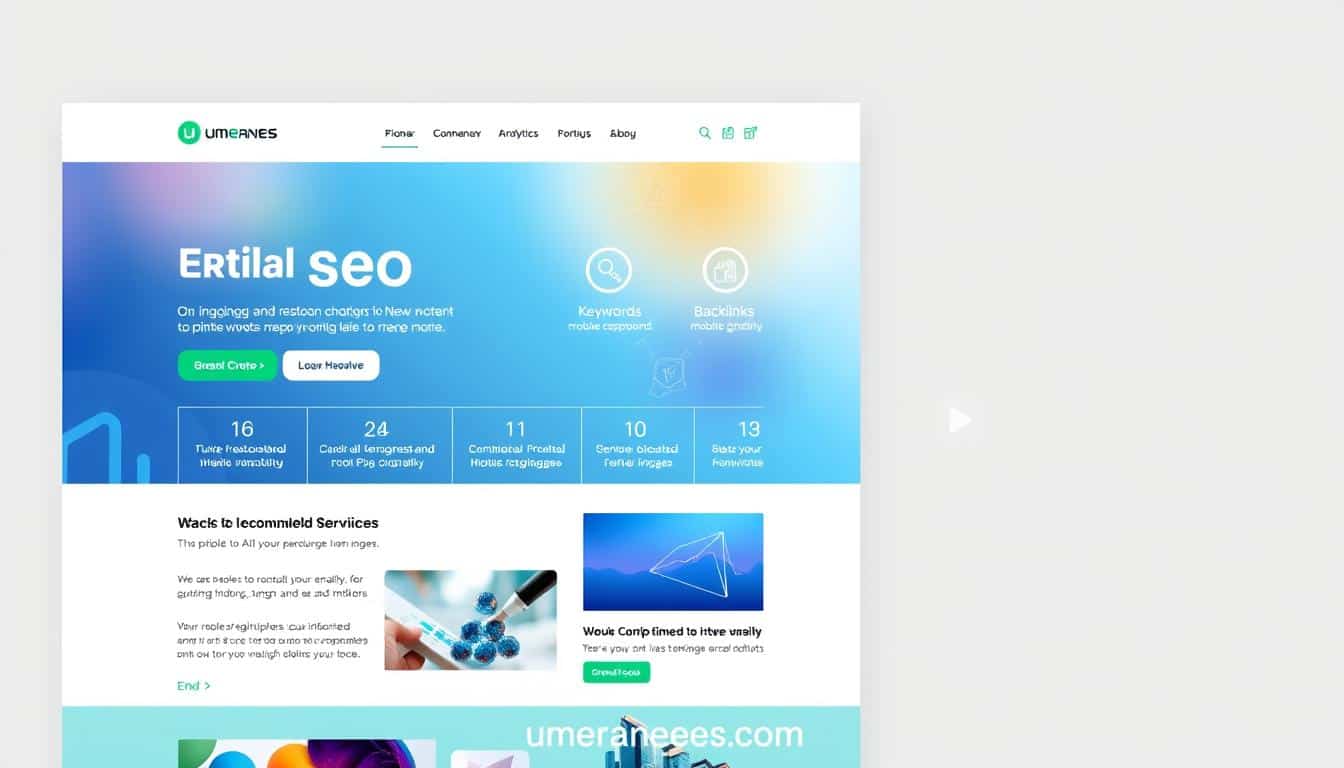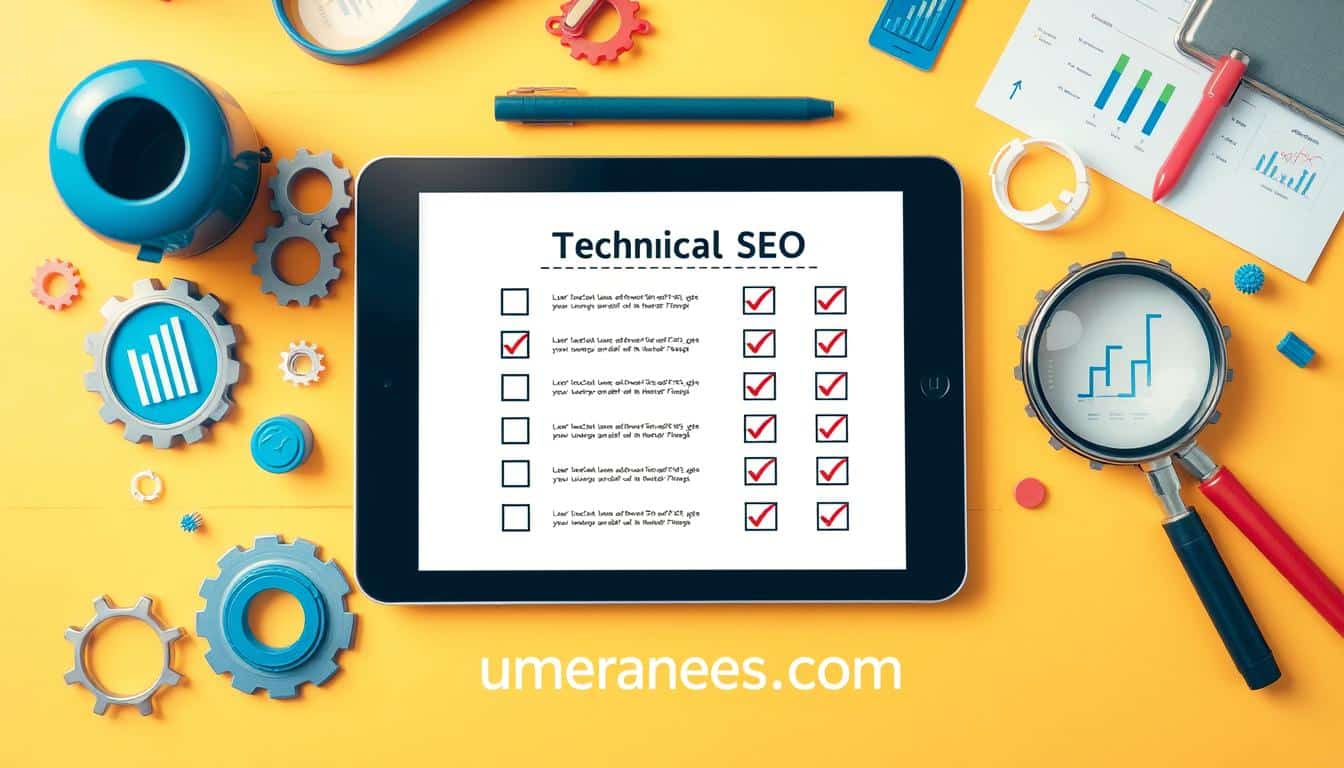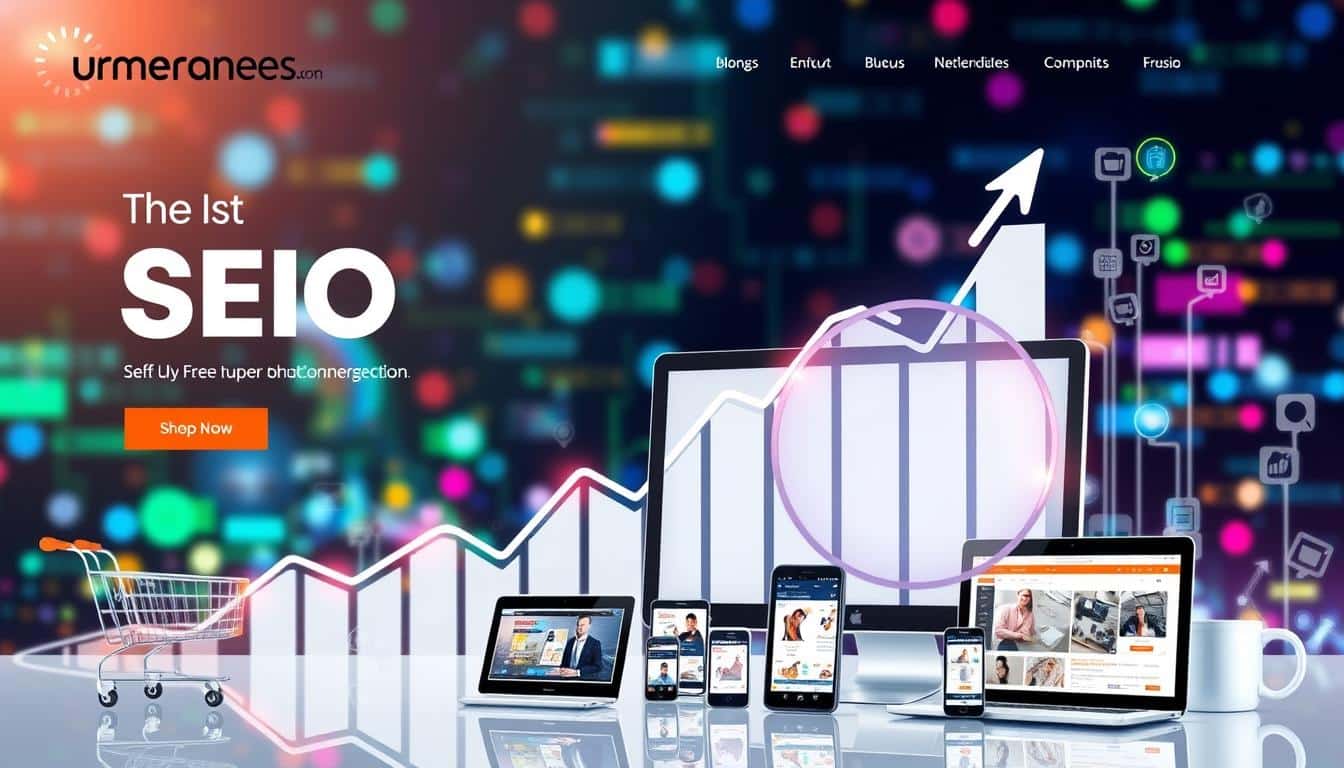In today’s digital landscape, where the competition for online visibility is fierce, crafting content that not only resonates with your audience but also ranks well in search engines has become a crucial skill. But the question is, how can you create content that checks all the boxes? The answer lies in understanding the fundamentals of content optimization and search engine ranking. In this comprehensive guide, I’ll take you through a step-by-step process to help you unlock the secrets of creating SEO-friendly content that will drive organic traffic to your website.
Key Takeaways
- Understand the basics of SEO and why it’s crucial for content creation
- Conduct thorough keyword research to identify the most relevant and high-performing terms
- Craft compelling headlines that capture the reader’s attention and optimize for search engines
- Optimize your content structure to enhance readability and improve search visibility
- Leverage SEO best practices, such as natural keyword integration and image optimization
Understand SEO Basics
Understanding the fundamentals of search engine optimization (SEO) is crucial for creating content that captivates your audience and drives organic traffic to your website. SEO is the process of optimizing your website and its content to improve its visibility and ranking in search engine results pages (SERPs), making it more accessible to potential customers.
What is SEO?
At its core, SEO is about understanding how search engines, like Google, operate and how they determine the relevance and authority of web pages. Search engines use complex algorithms to crawl, index, and rank websites based on a variety of factors, such as the quality and relevance of the content, the user experience, and the overall website structure.
Why SEO Matters for Content
Effective search engine optimization can significantly enhance the content visibility and organic traffic to your website. By optimizing your content, you can improve its discoverability, making it more likely to appear in the top search results for relevant queries. This, in turn, can lead to increased engagement, higher conversion rates, and a stronger online presence for your brand.
- Improved discoverability: SEO helps your content rank higher in search results, making it more accessible to your target audience.
- Increased organic traffic: By optimizing your content for search engines, you can attract more organic traffic to your website, without relying solely on paid advertising.
- Enhanced credibility: Appearing in the top search results can increase your brand’s credibility and authority in the eyes of your audience.
Remember, the key to effective SEO is to create valuable, informative, and user-friendly content that aligns with the needs and preferences of your target audience. By mastering the basics of search engine optimization, you can unlock the full potential of your content and drive meaningful results for your business.
Conduct Keyword Research
Crafting SEO-friendly content starts with thorough keyword research. By understanding the terms and phrases your target audience is searching for, you can optimize your content to rank higher in search engine results. Let’s dive into the tools and techniques that can help you uncover the most valuable keywords for your content strategy.
Tools for Keyword Research
Leveraging the right keyword research tools is essential for success. Platforms like SEMrush and Ahrefs provide in-depth insights into keyword search volume, competition, and related terms. The Google Keyword Planner is another powerful free tool that can help you identify the most relevant keywords for your industry or niche.
Analyzing Keyword Competition
Once you’ve identified a list of potential keywords, it’s important to analyze the level of competition for each one. Look at factors like search volume, the quality of existing content, and the authority of the top-ranking websites. This will help you prioritize keywords that offer the best opportunities for your content to rank well.
Long-Tail Keywords: The Hidden Gems
While popular, high-volume keywords can be attractive, don’t overlook the power of long-tail keywords. These more specific, low-volume terms tend to have lower competition and can often drive highly engaged traffic to your content. Keyword analysis tools can help you uncover these hidden gems and incorporate them into your content strategy.
| Keyword Research Tool | Key Features | Pricing |
|---|---|---|
| SEMrush | – Keyword research – Competitor analysis – Backlink analysis |
Starts at $99/month |
| Ahrefs | – Keyword research – Site explorer – Backlink analysis |
Starts at $99/month |
| Google Keyword Planner | – Keyword research – Search volume data – Ad-related insights |
Free |
“Effective keyword research is the foundation of any successful content strategy. It allows you to understand your audience’s search intent and create content that resonates with them.”
Craft Compelling Headlines
When it comes to SEO, your headline is the first thing that catches the reader’s eye in search engine results. A well-crafted headline can significantly impact your content’s click-through rate (CTR) and overall visibility. Let’s explore the importance of headlines in SEO and uncover tips for writing attention-grabbing titles.
Importance of Headlines in SEO
Headlines play a crucial role in SEO for several reasons. First, search engines use the headline, or title tag, as a primary factor in determining the relevance and topicality of your content. Optimizing your headlines with relevant keywords can help your pages rank higher in search results. Additionally, a compelling headline can entice users to click through to your content, improving your CTR and signaling to search engines that your content is valuable.
Tips for Writing Attention-Grabbing Headlines
Crafting headlines that are both SEO-friendly and captivating for readers can be a delicate balance. Here are some tips to help you create headlines that stand out:
- Incorporate relevant keywords: Include your target keywords in the headline, but avoid keyword stuffing. The goal is to make the headline natural and appealing.
- Focus on user benefits: Highlight the value or insights your content provides to the reader. Use words like “how-to,” “tips,” or “secrets” to pique their interest.
- Keep it concise: Aim for headlines that are 60 characters or less, as this is the optimal length for display in search engine results.
- Use active voice: Employ active language to create a sense of urgency and engagement. Avoid passive constructions.
- Test and iterate: Experiment with different headline variations and analyze their performance. Continuously refine your approach to find the most effective headlines.
By applying these strategies to your headline optimization efforts, you can create content that not only ranks well in search but also captures the attention of your target audience. Remember, a strong headline is the first step to driving more qualified traffic to your site.
| Headline | CTR | Rank |
|---|---|---|
| Unlock the Secrets to Headline Optimization | 12.5% | 2 |
| 7 Proven Tactics to Boost Your Click-Through Rate | 14.2% | 1 |
| Title Tags: The Unsung Heroes of SEO | 9.8% | 3 |
Optimize Content Structure
Crafting an SEO-friendly content structure is essential for improving the visibility and performance of your website in search engine results. The strategic use of headings, or content structure, plays a crucial role in this process.
The Role of Headings in SEO
Search engines rely on the hierarchical structure of your content to understand its organization and relevance. Properly formatted headings, such as H1, H2, and H3 tags, help search bots quickly grasp the main topics and subtopics within your content. This, in turn, enhances the search engine’s ability to index and rank your pages effectively.
Best Practices for Content Formatting
To optimize your content structure for better SEO, consider the following best practices:
- Use a clear and concise H1 tag to establish the main topic of the page.
- Incorporate relevant keywords naturally into your headings to signal the content’s relevance.
- Maintain a logical hierarchy by using H2 tags for main sections and H3 tags for subsections.
- Ensure that your paragraphs are concise and easy to read, with an average Flesch-Kincaid readability score between 8th and 9th grade level.
- Break up lengthy blocks of text with strategically placed subheadings to improve readability and scannability.
By optimizing your content structure through the effective use of headings and formatting, you can enhance the content structure and overall SEO performance of your website, making it more accessible and appealing to both search engines and your target audience.

“A well-structured and formatted content piece can significantly boost your website’s visibility and engagement with your audience.”
Write Valuable Content
Crafting high-quality, original content that resonates with your target audience is essential for effective SEO. To achieve this, it’s crucial to dive deeper into understanding your audience’s needs and preferences, as well as creating content that not only satisfies their search intent but also captivates their attention.
Understanding Your Audience
Audience research is the foundation of content creation. By thoroughly analyzing your target audience, you can gain valuable insights into their pain points, interests, and search behavior. This information will guide you in developing content that directly addresses their user intent and provides genuine value.
- Identify your audience demographics, such as age, location, and interests.
- Understand the challenges and questions your audience faces that your content can help solve.
- Analyze the keywords and search queries they use to find information related to your industry or niche.
Creating Original and Engaging Content
With a deeper understanding of your audience, you can now focus on creating content that not only meets their needs but also stands out from the competition. Developing content quality that is both informative and captivating is key to attracting and retaining your target audience.
- Conduct thorough audience research to identify content topics that resonate with your readers.
- Craft unique, well-researched, and in-depth content that provides genuine value to your audience.
- Incorporate engaging elements such as visuals, multimedia, and interactive features to enhance the user experience.
- Continuously monitor and adapt your content strategy based on audience feedback and performance metrics.
“The key to creating valuable content is to put yourself in the shoes of your audience and truly understand their needs and preferences.”
By focusing on user intent, delivering high-quality content quality, and conducting thorough audience research, you can craft content that not only ranks well in search engines but also resonates with your target audience, ultimately driving engagement and conversions.
Use SEO Best Practices
Crafting content that not only captivates your audience but also resonates with search engines is the key to unlocking your website’s true potential. In this section, we’ll delve into the essential on-page SEO techniques that can elevate your content’s visibility and drive more qualified traffic to your site.
Integrate Keywords Naturally
The strategic incorporation of on-page SEO keywords is crucial for optimizing your content. However, the key is to seamlessly weave these keywords into your writing, ensuring a natural and engaging reading experience for your audience. Avoid keyword stuffing, as this can negatively impact your content’s quality and search engine rankings.
Meta Descriptions: A Brief Overview
Your meta tags, particularly the meta description, play a pivotal role in enticing users to click through to your content from the search engine results page. Craft compelling, concise meta descriptions that accurately reflect the value of your content and incorporate relevant keyword density.
Image Optimization Techniques
- Optimize your image alt text to provide search engines with a clear understanding of the visual content.
- Choose descriptive file names that include your target keywords.
- Compress image files to ensure fast loading times, which is a crucial factor in on-page SEO.
By implementing these best practices, you can effectively leverage the power of on-page SEO to enhance your content’s discoverability and engagement with your target audience.
Internal and External Linking
When it comes to creating SEO-friendly content, the strategic use of internal and external linking plays a crucial role in boosting your website’s visibility and authority. By understanding the importance of these linking tactics, you can significantly enhance your content’s performance in search engine rankings.
The Importance of Internal Links
Internal links within your content not only help users navigate your website but also signal to search engines the structure and hierarchy of your pages. These links create a logical flow, allowing visitors to easily explore related content and spend more time on your site. Moreover, internal links distribute link equity, or “link juice,” throughout your website, strengthening the overall site authority and improving the visibility of individual pages.
Building Quality External Links
- External backlinks are essential for establishing your site’s authority and credibility in the eyes of search engines.
- Focus on acquiring link building opportunities from high-quality, relevant websites that align with your industry or niche.
- Craft anchor text that is natural and descriptive, avoiding over-optimization or excessive use of exact-match keywords.
- Regularly monitor your site authority and work on improving it through strategic external link building.
| Internal Link Benefits | External Link Benefits |
|---|---|
| Improved user experience and navigation | Increased website authority and credibility |
| Enhanced distribution of link equity | Improved search engine visibility and rankings |
| Stronger website structure and hierarchy | Expanded reach and referral traffic |
By carefully crafting an internal linking strategy and securing high-quality external backlinks, you can unlock the full potential of your content and boost your website’s overall SEO performance.
Leverage Social Media
In the digital age, social media platforms have become a powerful tool for [https://productlondondesign.com/write-seo-friendly-content/] social media optimization and content promotion. By crafting shareable content and engaging with your audience on various social channels, you can significantly boost your website’s visibility and drive more traffic.
Shareable Content Strategies
The key to successful social media engagement lies in creating content that your audience finds interesting, informative, and worth sharing. Leverage social media-friendly formats such as visuals, videos, and bite-sized tips to capture attention and encourage [https://productlondondesign.com/write-seo-friendly-content/] audience engagement.
- Develop a content calendar that aligns with your audience’s interests and preferences.
- Optimize your visuals with attention-grabbing graphics and eye-catching thumbnails.
- Experiment with different content formats, such as behind-the-scenes footage, industry insights, and user-generated content.
Engaging with Your Audience
Successful [https://productlondondesign.com/write-seo-friendly-content/] audience engagement on social media goes beyond simply posting content. Actively participate in conversations, respond to comments, and encourage your followers to share their thoughts and experiences.
| Social Media Platform | Engagement Strategies |
|---|---|
| Use relevant hashtags, participate in Twitter chats, and respond to mentions. | |
| Leverage Instagram Stories, create visually appealing content, and engage with your followers through likes and comments. | |
| Share industry insights, engage with your network, and participate in relevant discussions. |
By implementing these [https://productlondondesign.com/write-seo-friendly-content/] social media optimization and content promotion strategies, you can amplify your brand’s reach, build stronger relationships with your audience, and drive more traffic to your website.

“Social media is not just about building a brand; it’s about building relationships, one person at a time.” – Erin Bury
Monitor Performance
Tracking the success of your SEO efforts is crucial for understanding what’s working and where you can improve. By leveraging powerful tools like Google Analytics and Google Search Console, you can gain valuable insights into your content’s performance and make data-driven decisions to enhance your search engine visibility.
Tools for Tracking SEO Success
Google Analytics is a robust analytics platform that provides a comprehensive overview of your website’s traffic, user behavior, and conversion data. It allows you to track key metrics such as organic search traffic, bounce rates, and session duration, enabling you to identify high-performing content and areas for improvement.
Alongside Google Analytics, Google Search Console is an indispensable tool for SEO performance tracking. It offers detailed information about how your website appears in search results, including impressions, clicks, and average position. By analyzing this data, you can uncover opportunities to optimize your content and improve its ranking on search engine results pages (SERPs).
Analyzing Content Performance Metrics
- Organic Search Traffic: Monitor the number of visitors arriving at your site through organic search, as this directly reflects the success of your SEO efforts.
- Bounce Rate: Examine the percentage of users who leave your site after viewing only one page. A high bounce rate may indicate a need to improve content relevance or user experience.
- Time on Page: Assess the average time users spend on your content, as this can provide insights into the depth of engagement and the value your content provides.
- Conversion Rate: Track the percentage of users who take a desired action, such as making a purchase or signing up for a newsletter, to measure the effectiveness of your content in driving conversions.
By regularly monitoring these performance metrics, you can identify areas for optimization, make data-driven decisions, and continuously refine your SEO strategy to achieve better results.
“Data is the new oil. It’s valuable, but if unrefined it cannot really be used. It has to be changed into gas, plastic, chemicals, etc to create a valuable entity that drives profitable activity; so must data be broken down, analyzed for it to have value.”
– Clive Humby, Mathematician and Architect of Tesco’s Clubcard
Stay Updated on SEO Trends
In the fast-paced world of digital marketing, staying informed about the latest SEO trends and algorithm updates is crucial for maintaining a strong online presence. By closely following industry publications and adapting your content strategy accordingly, you can ensure your website remains visible and relevant to your target audience.
Following Industry News
Keeping up with the latest news and trends in the SEO industry is essential for staying ahead of the curve. Make a habit of regularly consulting trusted industry publications such as Search Engine Journal, Moz, and Ahrefs. These sources provide invaluable insights into the evolving search engine algorithms, emerging best practices, and strategies for optimizing your content.
Adapting to Algorithm Changes
Search engines are constantly refining their algorithms to deliver more relevant and personalized results to users. Adapting your content to these algorithm updates is crucial for maintaining your website’s visibility and rankings. Pay close attention to announcements from Google, Bing, and other major search engines, and be prepared to adjust your SEO tactics accordingly.
| SEO Trend | Key Takeaways |
|---|---|
| Voice Search Optimization | Optimize your content for voice search by using natural language, long-tail keywords, and featured snippets. |
| Video Content Prioritization | Incorporate more video content into your strategy, as search engines are placing greater emphasis on visual media. |
| Mobile-First Indexing | Ensure your website is mobile-friendly and provides a seamless user experience on smaller screens. |
By staying informed and adaptable, you can navigate the ever-changing landscape of SEO and ensure your content continues to rank well and engage your audience.
“The only constant in SEO is change. Staying up-to-date and nimble is the key to success.”
Create a Content Calendar
Crafting an effective content strategy is crucial for any successful SEO campaign. One powerful tool to help you achieve this is a content calendar. By creating a detailed editorial calendar, you can streamline your content planning, ensure a balanced topic coverage, and optimize your content for maximum impact.
Planning Your Content Strategy
The first step in creating a content calendar is to establish a clear content planning strategy. Start by identifying your target audience, their pain points, and the topics they find most engaging. This will help you align your content with their needs and interests, making it more valuable and relevant.
Next, conduct thorough keyword research to uncover the terms and phrases your audience is searching for. This will not only guide your content creation but also help you optimize your content for better search engine visibility.
Balancing Topics and Formats
With your content strategy in place, it’s time to start planning your content calendar. Aim to create a balanced mix of content types, including blog posts, infographics, videos, and social media updates. This will help you reach your audience through their preferred channels and keep your content engaging and diverse.
Consider implementing a topic clustering approach, where you group related content pieces together to establish your website’s authority on specific subjects. This can significantly boost your SEO performance and help you rank higher for your target keywords.
| Content Type | Frequency | Target Keywords |
|---|---|---|
| Blog Post | Weekly | content planning, editorial calendar |
| Infographic | Bi-weekly | topic clustering |
| Video | Monthly | content planning, editorial calendar, topic clustering |
By creating a well-structured content calendar, you’ll be able to stay organized, maintain a consistent publishing schedule, and ensure that your content aligns with your overall SEO strategy.
Encourage User Interaction
Fostering user interaction is crucial for enhancing the overall user experience and boosting engagement metrics that can positively impact your content’s SEO performance. By incorporating strategic calls-to-action (CTAs) and actively engaging with user comments and feedback, you can create a dynamic and responsive content ecosystem that drives conversions and strengthens your online presence.
Incorporating Calls-to-Action
Strategically placed CTAs can encourage your audience to take specific actions, such as subscribing to your newsletter, downloading a resource, or sharing your content on social media. Crafting compelling CTAs that align with your user’s needs and interests can significantly improve conversion rates and help you achieve your content marketing objectives.
Engaging with Comments and Feedback
Actively responding to user comments and feedback demonstrates your commitment to building a strong relationship with your audience. By addressing their questions, concerns, or suggestions, you can not only improve user satisfaction but also gather valuable insights that can inform your content strategy and enhance the overall user experience. This level of engagement can positively impact engagement metrics and contribute to your content’s search engine optimization.







